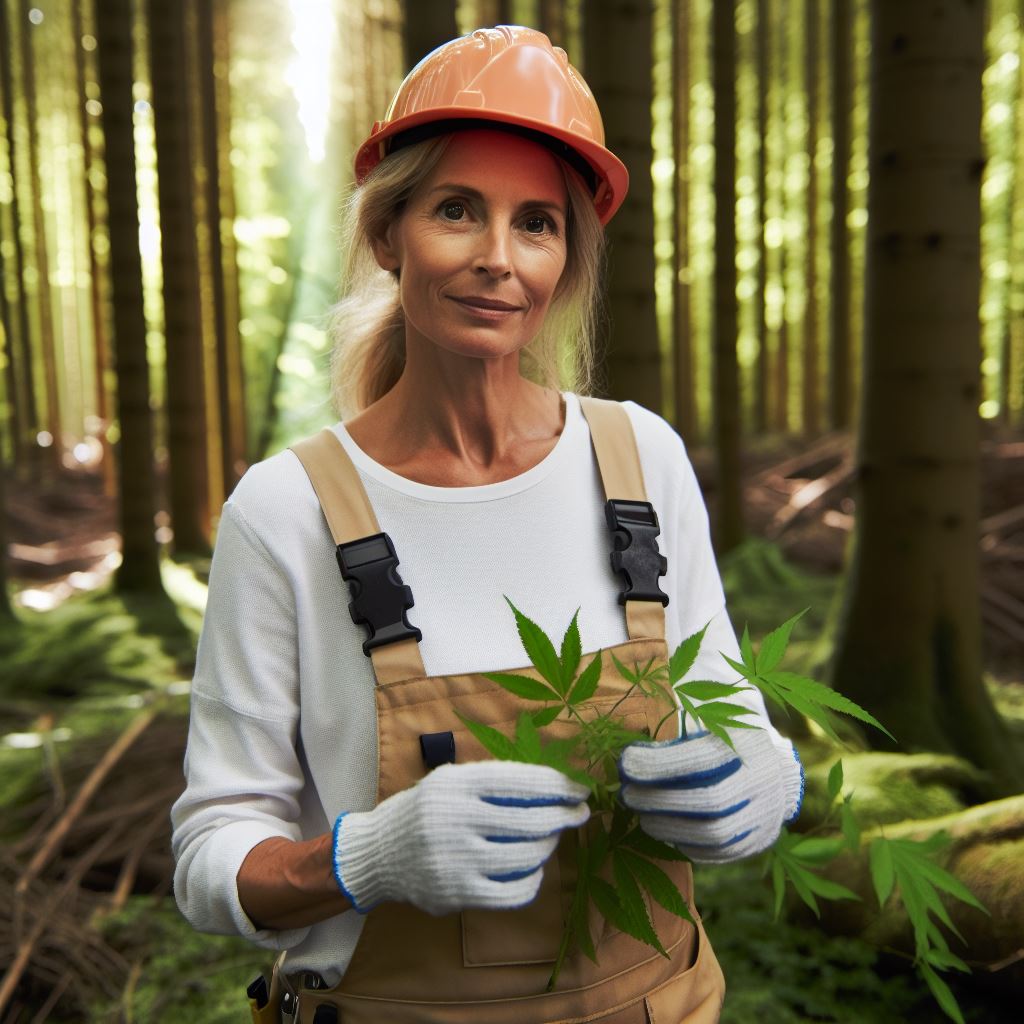Introduction
Foresters play a crucial role in managing UK forests, ensuring their sustainability and functionality.
They are essential in preserving biodiversity, which is vital for the health of ecosystems.
By actively managing forests, foresters can protect and enhance the diverse range of plant and animal species.
They contribute to the well-being of local communities, providing recreational spaces and conserving important habitats.
Foresters also focus on promoting the growth of indigenous trees, protecting endangered species, and preventing invasive species.
Their expertise helps maintain a balance between different habitat types, ensuring a rich and resilient ecosystem.
Through their work, foresters contribute to conserving the unique character and beauty of UK landscapes.
They actively monitor and control factors that can negatively impact biodiversity, such as disease, climate change, and pests.
Foresters play a vital role in sustainable forest management, ensuring resources are available for future generations.
Their efforts help maintain the delicate equilibrium between human needs and the preservation of biodiversity.
Foresters are essential in managing UK forests and preserving biodiversity for the benefit of present and future generations.
Overview of UK Biodiversity
Welcome to the next section of our blog series on the impact of foresters on UK biodiversity.
In this section, we will provide an overview of the existing biodiversity in the UK and highlight key species and habitats that are important for biodiversity conservation.
The United Kingdom is home to a rich and diverse array of flora and fauna, thanks to its varied landscapes and climate.
From rolling hills to expansive coastlines, the UK offers a range of habitats that support a wide variety of species.
When we talk about biodiversity, we’re referring to the variety of life on Earth, including all living organisms and their habitats. The UK boasts a remarkable level of biodiversity, with over 66,000 known species.
One of the key factors contributing to the UK’s biodiversity is its diverse range of habitats. These habitats include ancient woodlands, heathlands, wetlands, mountains, meadows, and coastal areas.
Each of these habitats provides a unique environment for different species to thrive.
Key Species and Habitats
Several species and habitats hold significant importance for biodiversity conservation in the UK. Let’s take a look at some of them:
- Red Squirrel (Sciurus vulgaris): The iconic woodland creature faces threats from the invasive grey squirrel, prompting efforts to protect and restore its habitats.
- Barn Owl (Tyto alba): The barn owl, symbolizing UK farmland habitats with its heart-shaped face, is a focus of conservation efforts. Initiatives aim to preserve nesting sites and minimize pesticide use.
- Hedgerows: These corridors of shrubs and trees are vital for providing shelter, food, and connectivity for a wide range of species, including birds, small mammals, and insects.
- Heathlands: These unique habitats are characterized by acidic soils and are home to a variety of specialized wildlife, such as the rare and endangered sand lizard and smooth snake.
- Coastal Areas: The UK’s coasts are teeming with biodiversity, supporting a wealth of marine life, seabird colonies, and important breeding sites for seals.
- Wildflower Meadows: These vibrant and species-rich grasslands are of great importance for pollinators like bees and butterflies, providing essential nectar and pollen sources.
Conserving key species and habitats is vital for UK biodiversity, yet habitat loss, pollution, climate change, and invasive species pose threats.
Foresters actively protect and manage habitats through sustainable practices like responsible timber harvesting and reforestation, fostering diverse woodland ecosystems.
They create a balance between human activities and biodiversity needs, ensuring preservation.
Next, we’ll delve into foresters’ impact on UK biodiversity, emphasizing their conservation efforts and sustainable forestry practices. Stay tuned!
Role of Foresters in Biodiversity Conservation
Responsibilities and Tasks of Foresters in Biodiversity Preservation
Foresters play a crucial role in preserving and protecting the biodiversity of forests in the UK. They have a range of responsibilities and tasks that contribute to the conservation of the natural environment.
- Conducting Surveys: Foresters are responsible for conducting surveys to assess the existing biodiversity within forests. They identify various species of plants, animals, and insects present in the ecosystem.
- Monitoring Wildlife: Foresters closely monitor the wildlife within forests to ensure their well-being and track any changes in population or behavior. They establish measures to protect endangered species and prevent invasive species from harming the ecosystem.
- Restoring Habitats: Engaging in habitat restoration, foresters recreate ideal conditions for native plant growth and survival, fostering suitable wildlife habitats.
- Implementing Conservation Strategies: Foresters develop and implement conservation strategies to mitigate the impact of human activities on biodiversity. They establish guidelines for sustainable logging, hunting, and other activities that may affect the ecosystem.
- Educating the Public: Foresters play a crucial role in educating the public about the importance of biodiversity preservation. They organize workshops, nature walks, and outreach programs to raise awareness and promote responsible behavior.
Forest Management to Promote Diverse Ecosystems
Foresters employ various techniques to manage forests effectively and promote diverse ecosystems that support a wide range of species.
- Biodiversity Hotspots: Foresters identify areas within forests that are rich in biodiversity and implement measures to protect and enhance their ecological value. These hotspots are preserved as important habitats for rare and endangered species.
- Selective Logging: Foresters practice selective logging, where only specific trees are cut down, leaving the rest of the forest intact. This technique helps maintain the overall integrity and structure of the ecosystem.
- Controlled Burns: Foresters use controlled burns as a management tool to clear out underbrush and promote the growth of certain plant species. This technique mimics natural wildfires and rejuvenates the forest floor.
- Creating Buffer Zones: Foresters establish buffer zones around sensitive areas within forests. These zones act as protective barriers against invasive species, pollution, and other threats, preserving the integrity of the ecosystem.
- Adopting Sustainable Practices: Foresters promote sustainable forestry practices, such as planting diverse tree species and managing invasive plants. These practices help maintain biodiversity while ensuring the long-term productivity of the forest.
Specific Techniques Used by Foresters to Support Biodiversity
Foresters employ various specific techniques to support biodiversity conservation and ensure the long-term health of forests.
- Tree Planting: Foresters engage in large-scale tree planting programs to restore and expand forested areas. They carefully select tree species that contribute to biodiversity and improve the resilience of the ecosystem.
- Wildlife Corridors: Foresters create wildlife corridors that connect fragmented habitats. These corridors allow animals to move freely, ensuring gene flow and enhancing biodiversity.
- Invasive Species Management: Foresters actively manage invasive plant species that threaten native biodiversity. They develop strategies to control and eliminate these species, preventing them from overtaking and disrupting the ecosystem.
- Nest Boxes and Artificial Habitats: Foresters install nest boxes and construct artificial habitats to provide additional nesting sites for birds, bats, and other wildlife. These structures help support biodiversity by providing safe breeding environments.
- Collaboration with Stakeholders: Foresters collaborate with various stakeholders, including government agencies, environmental organizations, and local communities.
By working together, they develop effective biodiversity conservation plans and ensure their implementation.
Generally, foresters have a vital role in biodiversity conservation in the UK.
Through their responsibilities, tasks, and various techniques, they contribute to the preservation and enhancement of diverse ecosystems within forests.
Their efforts are essential to maintaining the delicate balance of nature and protecting the plethora of species that call these forests their home.
Foresters’ Impact on Habitat Restoration
Role of foresters in restoring and maintaining habitats for various species
Foresters play a crucial role in restoring and maintaining habitats for various species.
They contribute significantly to the protection and preservation of ecosystems, ensuring the survival of diverse flora and fauna populations.
In addition to specific habitats, foresters also focus on restoring and protecting rare and endangered species’ habitats.
They identify areas where these species are at risk and implement conservation strategies to ensure their survival.
Through careful management and habitat restoration, foresters effectively safeguard critical habitats that support endangered plants and animals.
Specific examples of habitat restoration projects led by foresters in the UK
One notable example of habitat restoration led by foresters is the reforestation of degraded lands.
By planting trees and restoring forest habitats, foresters create suitable environments for numerous species to thrive.
This initiative not only improves biodiversity but also mitigates the effects of climate change by sequestering carbon dioxide.
Another important aspect of habitat restoration led by foresters is the creation of wildlife corridors.
These corridors provide safe passages for animals to move between fragmented habitats, increasing genetic diversity and enhancing the overall health of populations.
Foresters collaborate with landowners and communities to establish these corridors and ensure the uninterrupted flow of species across different habitats.
These restoration projects also contribute to the protection of ecosystem services. Healthy and diverse habitats provide essential benefits such as water purification, pollination, and carbon sequestration.
By restoring and preserving these habitats, foresters ensure the continuity of these services, benefiting both wildlife and human communities.
The positive impact of these projects on biodiversity
Foresters also actively engage in wetland restoration projects. Wetlands are vital ecosystems that support a wide array of plants and animals.
By restoring wetlands, foresters help sustain the habitat of various bird species, amphibians, and aquatic organisms. These efforts are crucial for preserving biodiversity and promoting ecological balance
Furthermore, foresters actively engage in the restoration of riparian zones. These are the areas along rivers and streams that are crucial for aquatic biodiversity.
By planting native vegetation, stabilizing banks, and improving water quality, foresters play a significant role in restoring these fragile ecosystems.
Personalized UK Career Consulting
Receive tailored career guidance designed just for you. Get actionable steps and expert support to boost your career in 1-3 days. Take control of your career now.
Get StartedThe positive impact of these projects on biodiversity cannot be overstated. Habitat restoration efforts led by foresters have resulted in the recovery of numerous species, some of which were on the brink of extinction.
The reintroduction of suitable habitats has allowed populations to rebound and thrive.
Foresters play a vital role in habitat restoration, ensuring the survival and well-being of numerous species.
Their efforts in reforestation, wetland restoration, rare species conservation, wildlife corridors, riparian zone restoration, and other initiatives have had a profound positive impact on biodiversity.
By understanding the importance of their work, we can appreciate the crucial role foresters play in maintaining the delicate balance of ecosystems and fostering a sustainable future for our planet.
Read: UK Farming Subsidies: Understanding the Basics

Foresters’ Role in Tree Selection and Planting
Foresters play a crucial role in selecting and planting tree species to contribute to the conservation of UK biodiversity.
This section will explore how foresters select trees based on ecological characteristics, the importance of maintaining a diverse range of tree species, and how strategic planting can enhance biodiversity.
Selecting Tree Species based on Ecological Characteristics
Foresters carefully assess the ecological characteristics of tree species to ensure their suitability in specific habitats. They consider factors such as soil type, moisture levels, temperature, and sunlight requirements.
For example, if a site has poor drainage, foresters will choose tree species that are tolerant of wetter conditions.
This approach ensures that the selected trees will have a higher chance of survival and successful establishment.
By matching tree species to their ecological requirements, foresters can create resilient and healthy forests that support a wide range of biodiversity.
The Importance of Maintaining a Diverse Range of Tree Species
Foresters recognize the significance of maintaining a diverse range of tree species in promoting and preserving biodiversity.
Monocultures, where a single tree species dominates, can have negative ecological impacts.
By planting diverse tree species, foresters create complex forest ecosystems that provide habitat for a variety of wildlife, including insects, birds, mammals, and fungi.
Each species serves a unique role in the ecosystem, contributing to its overall resilience.
Diverse forests also help mitigate the effects of climate change and provide valuable ecosystem services, such as water filtration, carbon sequestration, and soil fertility maintenance.
The Role of Foresters in Strategic Tree Planting
Foresters strategically plan tree-planting initiatives to enhance biodiversity and ecosystem resilience.
They consider factors such as natural regeneration potential, connectivity, and the specific needs of target species.
Strategic planting can create woodland corridors, connecting fragmented habitats and promoting the movement of wildlife.
This connectivity enables animals to find suitable resources, breed, and disperse seeds, contributing to the overall health of ecosystems.
Foresters also identify areas where certain tree species are rare or endangered and prioritize their reintroduction.
By focusing on these species, foresters contribute to their conservation and help maintain genetic diversity.
Foresters are essential in selecting and planting tree species to promote UK biodiversity.
By matching trees to ecological characteristics, maintaining diversity, and strategically planting, foresters create resilient forests that benefit both wildlife and the environment.
Your Dream Job Starts with a Perfect CV
Get a tailored CV and cover letter that captures your unique strengths and stands out in your industry. Let us help you make an unforgettable first impression.
Get StartedTheir dedication to tree selection and planting drives the conservation and restoration of UK biodiversity, ensuring a sustainable future for generations to come.
Read: The Evolution of Fishing in the UK: A Journey
Learn More: Climate Change and UK Forestry Roles
Foresters’ Contribution to Sustainable Forest Management
The connection between sustainable forest management and biodiversity conservation
Foresters play a crucial role in promoting sustainable forest management and conserving biodiversity.
Let’s discuss the connection between these two concepts and explore how foresters ensure the long-term health and sustainability of forests while protecting biodiversity.
We will also look at the certification schemes and regulations that assist foresters in their sustainability efforts.
Continued research and monitoring also enable foresters to adapt their practices and improve biodiversity conservation.
They constantly evaluate the impact of their activities on species and ecosystems, identifying areas for improvement and implementing necessary changes.
How foresters ensure the long-term health and sustainability of forests while protecting biodiversity
Sustainable forest management is closely linked to biodiversity conservation. Forest ecosystems support a diverse range of plant and animal species, providing them with habitats, food sources, and shelter.
By sustainably managing forests, foresters can maintain and enhance the biodiversity within these ecosystems.
Foresters employ various strategies to ensure the long-term health and sustainability of forests while also conserving biodiversity.
They carefully plan and implement logging practices, ensuring they do not exceed the natural regrowth rate of trees. This allows forests to regenerate and continue providing crucial habitats for species.
In addition, foresters work to minimize the negative impacts of logging on biodiversity. They selectively harvest specific tree species, preserving the diversity of plant life within the forest.
By doing so, they maintain the integrity of the ecosystem and prevent the displacement or extinction of certain species.
Foresters also prioritize maintaining the structural diversity of forests. They strategically design logging patterns, leaving certain areas untouched to preserve habitats for sensitive species.
These protected areas act as refuges, allowing plants and animals to thrive and ensuring the overall resilience of the ecosystem.
Certification schemes and regulations that help foresters in their sustainability efforts
To support their sustainability efforts, foresters often adhere to certification schemes and regulations.
Forest Stewardship Council (FSC) certification is widely recognized and requires foresters to follow strict biodiversity conservation guidelines.
This certification ensures that forests are managed in a way that protects wildlife habitats and promotes sustainable practices.
Regulations such as the UK Forestry Standard also play a crucial role in guiding foresters towards sustainable forest management.
These regulations outline best practices for maintaining biodiversity and preventing damage to ecosystems during forest operations.
Compliance with these standards is essential for foresters to obtain licenses and permits for their activities.
Furthermore, forest management plans are developed in consultation with ecologists and environmental experts.
This collaborative approach ensures that all biodiversity concerns are taken into account and that management actions align with conservation goals.
Foresters contribute significantly to sustainable forest management and biodiversity conservation.
Their crucial role in maintaining forest health involves planning and executing logging practices, protecting habitats, and adhering to certification schemes and regulations, all devoted to preserving biodiversity.
By striking a balance between economic needs and environmental conservation, foresters play a vital role in ensuring the future of our forests and the diverse species that inhabit them.
Read: Modern Fishing Gear: UK Fishermen’s Toolkit
Delve into the Subject: Technology’s Impact on Modern UK Farming
Optimize Your LinkedIn for Success
Boost your LinkedIn profile with a professional bio, keyword-rich headline, and strategic recommendations that attract recruiters. Stand out from the crowd and get noticed.
Optimize NowChallenges Faced by Foresters in Biodiversity Conservation
Preserving biodiversity is crucial for the sustainability of ecosystems, and foresters play a key role in this task.
Potential challenges faced by foresters in their efforts to preserve biodiversity
- Climate Change: Foresters confront the challenge of adapting to climate change impacts on biodiversity, addressing shifting weather patterns, rising pest and disease outbreaks, and altered growth rates of tree species.
- Invasive Species: Non-native plants, insects, and animals threatening native biodiversity demand foresters’ attention. Tackling their spread is crucial to prevent disruption in local ecosystems.
- Lack of Funding or Resources: Insufficient funding and resources pose a crucial challenge for foresters. Limited budgets can impede their ability to implement effective conservation strategies, conduct research, or acquire necessary equipment.
- Fragmentation and Habitat Loss: Foresters have to address the challenge of habitat loss due to urbanization and land conversion for agricultural purposes. Fragmentation of forests leads to reduced connectivity among ecosystems, affecting biodiversity.
- Illegal Logging and Wildlife Trade: Foresters face challenges in combatting illegal logging activities and the associated wildlife trade. These activities pose a threat to both forest ecosystems and endangered species.
- Lack of Awareness and Education: Many people are unaware of the value and importance of biodiversity conservation. Foresters must overcome this challenge by raising awareness and educating the public about the significance of preserving biodiversity.
- Policy and Governance Issues: Policy and governance challenges confront foresters. Inadequate or conflicting regulations and policies may impede their effective implementation of conservation measures.
- Limited Collaborations and Support: Collaboration among various stakeholders, such as government agencies, local communities, and NGOs, is essential for successful biodiversity conservation. Foresters face challenges in fostering these collaborations and obtaining the necessary support.
Overcoming the Challenges
To address these challenges and preserve biodiversity effectively, collaboration and support play a crucial role. Key strategies include:
- Strengthening Partnerships: Foresters should work closely with other sectors, such as agriculture and urban planning, to integrate biodiversity conservation into their practices.
- Increasing Funding and Resources: Securing adequate funding and resources is vital to enable foresters to implement robust conservation strategies and research initiatives.
- Implementing Strict Policies and Regulations: Effective policies and regulations need to be developed and enforced to address issues like illegal logging and invasive species.
- Enhancing Public Awareness and Education: Foresters should engage in educational campaigns to raise public awareness about the importance of biodiversity and sustainable forest management.
- Building Capacity and Training: Providing training and capacity-building opportunities for foresters can enhance their skills and knowledge in biodiversity conservation.
- Supporting Research and Innovation: Investing in research and promoting innovation can lead to the development of more efficient and sustainable biodiversity conservation techniques.
Foresters face several challenges in their efforts to preserve biodiversity in the UK.
However, by collaborating with relevant stakeholders, increasing funding and resources, and implementing effective policies, these challenges can be overcome.
It is crucial to recognize the value of biodiversity conservation and support the dedicated individuals working towards this goal.
Read: UK Fishing Laws: What Every Fisherman Must Know
You Might Also Like: Livestock Farming in the UK: Ethics and Practices
You Might Also Like: UK Farming: Challenges and Rewards Explained
Conclusion
In the intricate tapestry of UK biodiversity, foresters stand as unsung heroes, crafting landscapes where ecosystems thrive.
Their diligent stewardship not only maintains but enhances the delicate dance of species and habitats.
The symphony of biodiversity owes its harmony to their deliberate actions.
Foresters are architects of resilience, ensuring that the fabric of nature remains robust against the strains of environmental shifts.
Their work is not just a profession; it’s a commitment to the collective well-being of our ecosystems.
The lush woodlands, the thriving flora, and the myriad fauna owe their existence to these guardians.
As we tread upon the verdant trails, let us pause to acknowledge the foresters’ silent symphony, their impact resonating through every rustle of leaves.
Embrace the call to stand beside them, fostering a world where biodiversity is not just preserved but celebrated – a testament to the enduring legacy of those who nurture the very essence of life.
[E-Book for Sale]
500 Cutting-Edge Tech Startup Ideas for 2024 & 2025: Innovate, Create, Dominate
$19.99 • 500 Tech Startup Ideas • 62 pages
You will get inspired with 500 innovative tech startup ideas for 2024 and 2025, complete with concise descriptions to help you kickstart your entrepreneurial journey in AI, Blockchain, IoT, Fintech, and AR/VR.




